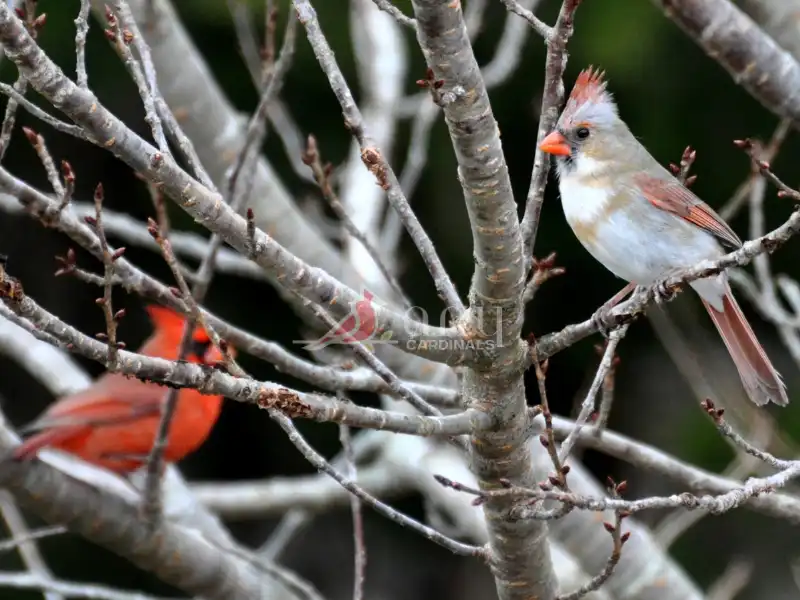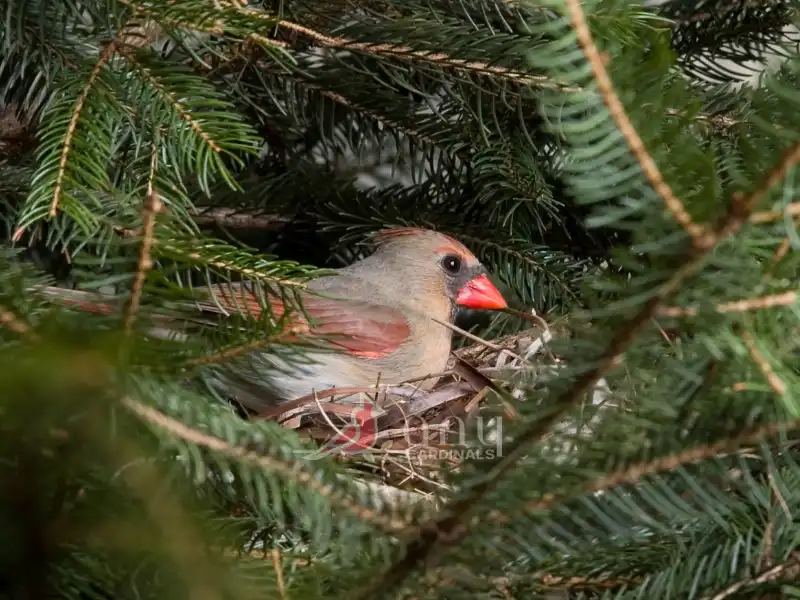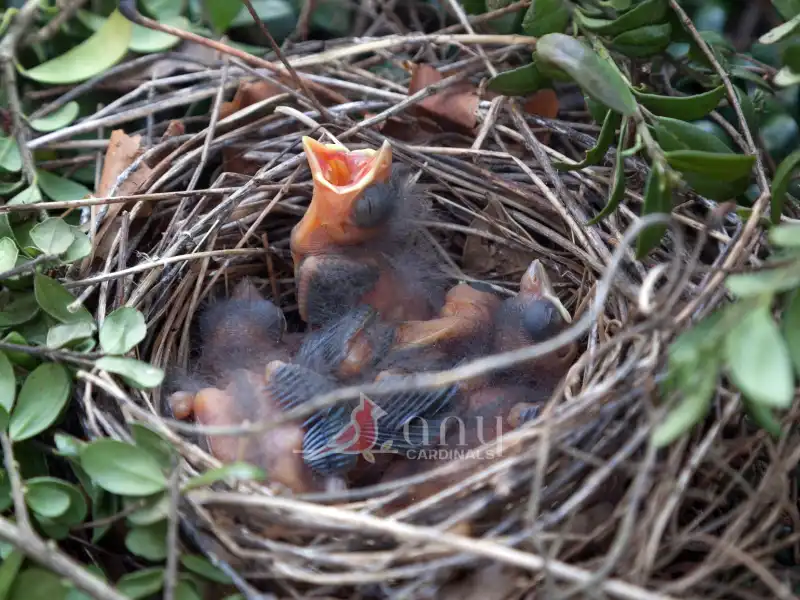Cardinal is famous for its vibrant plumage and melodic songs. But cardinal behavior makes it a centerpiece of attraction among many avian experts.
How this birdie behaves in specific situations always sparks curiosity among bird watchers. They think about how this bird attracts its mate, what behaviors it displays during courtship, and more.
If you are also seeking information on these topics, we recommend reading this comprehensive article. Hence, let’s dive deep into the content.
Related Articles
Overview of Cardinal’s Behavior
By cardinal, we understand the mighty, colorful, and medium-sized Northern Cardinal. However, this article covers the behavioral patterns of the Northern and other cardinal types.

Let’s begin with the famous one. The Northern Cardinal is a cheerful bird. It loves to form a life-long bond with its mate. Besides, this birdie exhibits interesting behavior to attract its mate.
The Northern Cardinal prefers taking on family responsibilities. For example, it protects the family in the breeding season. It deals with the food collection and distribution chores for its family.
The Northern Cardinal also displays unique behavioral patterns that match its other types. Let’s explore those behaviors by reading the entire blog post.
If you want to know more all about cardinal bird! You can read this article
Territorial Behavior
The Northern Cardinal, especially the male one, goes territorial during the breeding season. The male cardinal doggedly protects its territory at this time.
Also, it chases away intruders and indulges in fights with other birds. If you have read our other blog posts, you may know that the cardinal shows quite peculiar behavior in the breeding season.

For instance, it can attack its reflections in windows, car mirrors, and other reflective surfaces. However, the female Northern Cardinal doesn’t behave as aggressively as a male bird.
The female bird exhibits a little aggressive behavior in winter. A female cardinal may even fiercely fight to protect its territory from intruders.
Mating Behavior
Cardinals show interesting mating behavior during the breeding season. Here is how they attract mates and display other behaviors during this time.
Communication:
The male Northern Cardinal starts courtship behavior by standing upright while keeping its head and chest facing the sky.
It smoothes its feathers and tail and produces loud songs featuring beautiful whistles. Not only this, but a male cardinal also starts shifting from side to side while singing.
It shows off this song and dance performance to attract a female. Once it draws a female cardinal, it picks up a seed and feeds the female to convince the bird that the male cardinal can feed and protect her.
Only the Northern Cardinal shows this unique mating behavior. Other types, such as the Red-crested Cardinal, yield calls and perform strutting and fanning activities to attract mates.
Nesting and Reproduction Behavior of Cardinal
After forming a lifelong bond with mates, both male and female Northern Cardinals collaboratively perform various duties for successful nesting and reproduction.
They choose shrubs, vines, and dense vegetation to build their nests. The female Northern Cardinal is primarily responsible for constructing nests using twigs, leaves, grasses, and other plant materials.

On the contrary, the male bird collects nest-building materials and assists the female bird in developing their home.
Once the female Northern Cardinal lays eggs and starts incubating those eggs, the male bird becomes responsible for providing food and protection for the family. You can learn more on this topic in the following section.
Egg-laying and Incubation
After building a nest and mating, the female Northern Cardinal lays 2-3 eggs. These eggs tend to be greenish, buffy, or grayish-white. Also, these eggs feature pale gray or brown speckles.
The female Northern Cardinal starts incubating those eggs for around 11 to 13 days. At this time, she always remains seated on top of those eggs while the male cardinal stays busy bringing food for her.
Additionally, the male cardinal constantly patrols his territory in search of intruders. He can become incredibly territorial and fight with other birds or animals during the breeding season.

These are primary behaviors that the Northern Cardinal shows off once the female cardinal lays eggs and starts incubating.
Sadly, we don’t know much about the nesting and incubation behaviors of other cardinal types due to a lack of information/research.
We will talk about these magnificent birds’ parenting behavior in the next section.
Parenting Behavior
Ornithologists have noticed a blend of love, care, and aggression in the Northern Cardinal’s behavior, especially when a pair becomes a parent. Here’s what they found.
01. Feeding Behavior
Before disclosing how the Northern Cardinal feeds its babies, we will discuss what this birdie usually consumes. Well, this bird is a seed eater. It munches on black oil sunflower and Nyjer seeds.
Besides this, the Northern Cardinal eats peanuts, suet, cracked corn, leaf buds, flowers, grass seeds, berries, and many insects.
This bird keeps beetles, bugs, grasshoppers, caterpillars, ants, flies, and even spiders in its insect diet.

And that’s what it primarily feeds to its babies. The Northern Cardinal feeds its babies mashed insects. Usually, the male bird catches, mashes, and feeds those bugs to offspring.
Alongside this, the dad flies, hops down to a bird feeder, and pecks off one or more pieces of food. Then, he returns to the nest and feeds those foods to baby cardinals.
Both male and female cardinals equally contribute to feeding chicks. On average, both birds make hundreds of trips to the nest daily, especially during the first few weeks after hatching.
As the baby birds age, the feeding frequency gradually decreases. Both male and female birds provide food until the young cardinals get ready to leave the nest.
02. Parental Care
Male and female Northern Cardinals take ultimate care of their babies. While the female birdie stays busy warming up babies once they hatch, the male bird protects them from predators.
Cardinal parents remain quite attentive in their behavior. For example, the female bird sings a short song while producing a gurgling sound before leaving the nest.
Ornithologists believe that it can be a signal for her mate. She produces such a sound to notify the male bird that she is leaving the nest.
However, when the female gives the signal and leaves the nest, the male bird instantly appears to look after baby birds.
Once baby cardinals become fledglings within 10 to 12 days of hatching, they leave the nest. Still, their parents take care of them.
The male cardinal starts teaching those baby birds essential survival skills like foraging for food, avoiding predators, and finding safe roosting spots.
Response to Human Presence
The Northern Cardinal and its other types, like the Desert Cardinal, Vermilion Cardinal, Yellow Cardinal, and more, are pretty social. Under normal circumstances, these birdies don’t perceive humans as a threat.
That being said, let’s learn more about cardinals’ social behavior and other interactional patterns.
01. Social Behavior
The Northern Cardinal prefers staying in territory surrounded by humans. This bird spends hours in gardens, parks, and other areas where humans often visit.
Not only this, but this striking bird can also recognize human faces and voices. It can form a pleasant bond with humans!
Researchers have seen that cardinals can frequently visit particular people’s backyards whom they consider friends. This bird likes to observe people and eat food from those people’s bird feeders.

Even though the Northern Cardinal is a bit skittish, it doesn’t flee away after encountering humans. This bird’s highest possible action upon being threatened by humans is to perch from one tree branch to another.
02. Interaction with Other Animals
During the breeding season, the Northern Cardinal moves around in pairs. This bird joins a large flock containing a dozen birdies in fall and winter.
Then, this group collectively looks for food. The Northern Cardinal also flies with other bird species while foraging for food; it might join a flock of dark-eyed Juncos, Tufted Titmice, Sparrows, and Goldfinches.
The Northern Cardinal remains in a group of birds throughout winter. Alongside staying together, this bird often shares food with other birds, especially while feeding from a bird feeder.
Amazingly, the Northern Cardinal even feeds other birds as well. When the male cardinal brings food for his offspring, he often mistakenly feeds other birds’ nestlings or fledglings en route!
Not only this, but the Northern Cardinal even incubates the Brown-headed Cowbird’s eggs. Usually, this bird lays one or more eggs in a cardinal’s nest as it doesn’t have any nest.
Unfortunately, the Northern Cardinal can’t distinguish its eggs from the Brown-headed Cowbirds’ ones. So, cardinals end up incubating and raising offspring of other bird species.
Interesting Behavior of Cardinals
Now, you know virtually everything about the behavioral pattern of Northern Cardinal and its types. Still, we have some more to share on this bird’s behavior. Hence, let’s read further.
- The female Northern Cardinal can sing louder than the male bird. It does it to tell the male bird to bring food for her.
- As you know, the Northern Cardinal and its types remain territorial during the breeding season. This Northern red bird might attack other birds to protect its family and territory. Even it might attack its reflection in mirrors!
Frequently Asked Questions
01. How Do Cardinals Show Affection?
The male Northern Cardinal displays affection by feeding seeds to the female. When the male bird feeds the female, it looks like both birds are kissing.
02. Are Red Cardinals Aggressive?
The Northern Cardinal is aggressive to some extent. It becomes aggressive during the breeding season. Other times, it remains a pretty social, shy, and calm bird.
03. Are Cardinals Friendly? Can You Befriend a Cardinal?
Cardinals have no problem visiting the backyard or eating food from bird feeders. Nor do they bother about human presence until it’s breeding time. But you can’t befriend or pet a cardinal as it is illegal.
Wrapping Up
The cardinal’s behavior consists of a combination of territoriality, vocal communication, and distinctive courtship displays. These behavioral patterns set cardinals apart from other birdies.
You can hardly find other birds matching cardinals’ behavior. Although we know quite a detail about this bird’s behavior, there is still much to discover and learn.
We recommend you frequently visit this web page for updated information and stay in touch with our Facebook, Twitter, and Pinterest.

